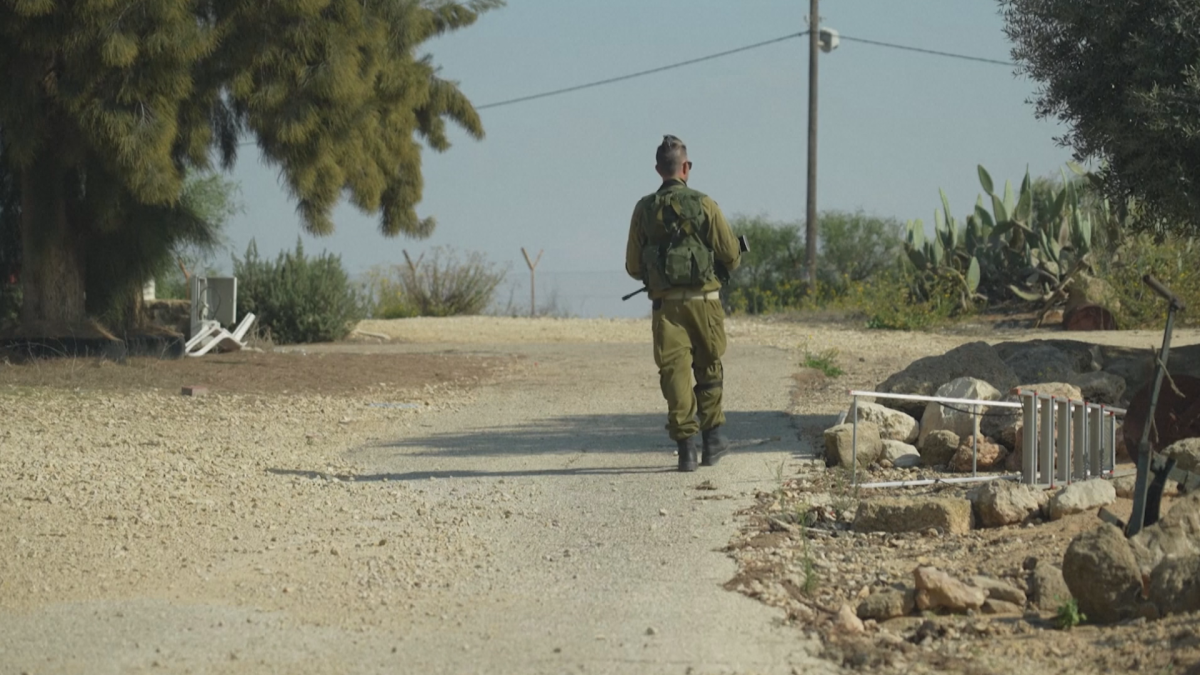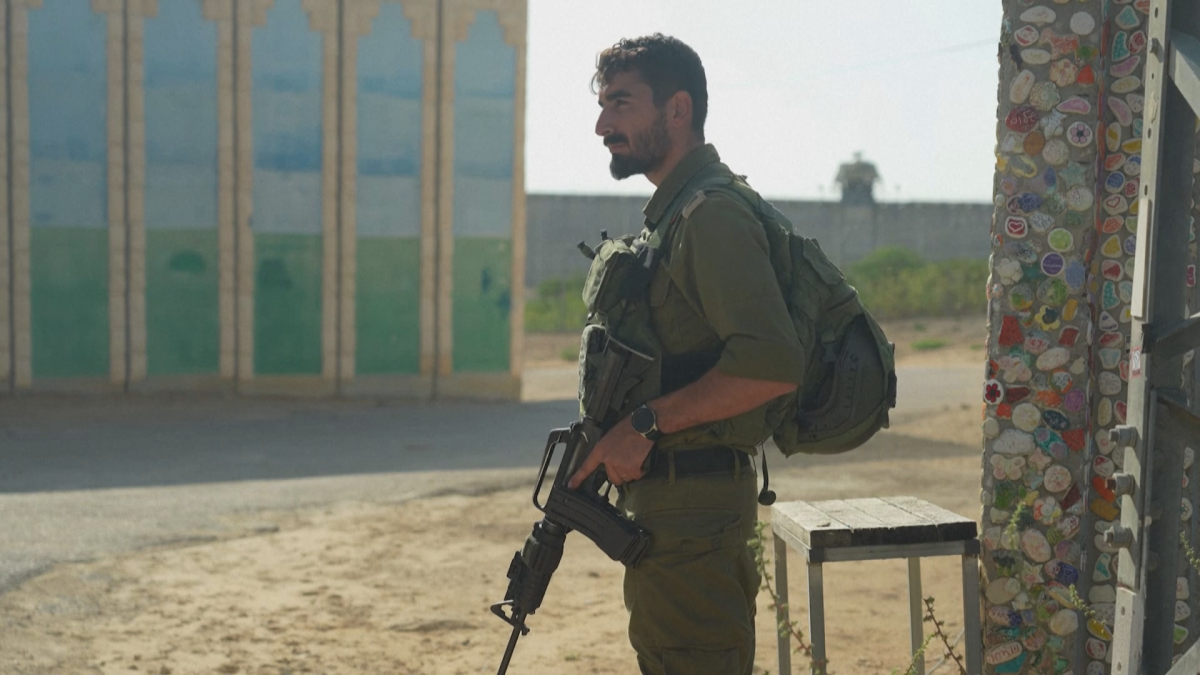On Nov. 17, 2023, the Israeli government’s Global Press Office organized a tour of a village on the border with the Gaza Strip.

Netiv HaAsara is just metres from the border fence at the north end of Gaza and was one of the first communities hit in the Hamas attacks on Oct. 7.
Twenty people from the community were killed, according to Israeli authorities. Global National correspondent Michael Armstrong is in the region covering the conflict and took part in the tour.
The first sign the bus was getting closer to the conflict came a few kilometres from the village. Fields along the road had been plowed and turned into parking lots for tanks and armoured personnel carriers.
But it was about five minutes out when the bus packed with journalists started to get quieter.
As the bus took a curve in the road, out the left side we could see a massive plume of smoke off in the distance. It was something we had all seen in coverage of the conflict on television and in photos, but this seemed unimaginably huge. It made you think that if it looked this big from kilometres away, what would it be like to be near it?
It was also impossible not to find yourself thinking, “Oh, I guess we really are close.”
The bus carried about 50 international journalists from around the world. There weren’t enough seats. Even the aisles were packed. As we arrived, we were given the ground rules.
You can film soldiers — but ask them first.
You can go into houses, if you’re invited in — but don’t film personal photographs on the walls.
And everyone had to wear a flak jacket — whether you wore a helmet was up to you. I went with a ball cap and, as you’ll see, kind of regretted it later.

Netiv HaAsara isn’t just close to Gaza — it’s tucked up right against it. Some homes at the southern end are just 15 or 20 metres from the border wall. The village has a population of about 800, but since Oct. 7 it has been declared a closed military zone by the Israeli government. Residents are spread out in hotels in other parts of the country.
Home after home sits empty. It felt like a ghost town.

Get daily National news
“Today, nobody lives here,” says Hila Fenlon. “We’re not allowed to come back.”
Fenlon was one of two residents who returned to talk to journalists about the village and the horrors people lived through there.
Benny Vainer, a 38-year-old photographer, says that on the morning of the attacks, he heard shooting and explosions. He says he knew it was close. Homes in the village have bomb shelters because rockets are occasionally fired from Gaza, but Vainer says he knew this was different.
He piled into his bomb shelter with his family, his mother-in-law, and some neighbours.
“We waited for the army,” Vainer says. “We thought they’d come in 10 minutes.”
What Vainer didn’t know was that his village was just one of 20 Israeli border communities being hit. Huddled together with people he wanted to protect, he decided that if Hamas fighters got close, he would run to distract them from the people hiding in his home.
“I knew I’d be killed,” he said. He then gestured over his shoulder. “Like my friends over there.”
The Hamas fighters flew over the border wall on paragliders. Walking through town, Fenlon points to a vacant lot.
“One of them landed there,” she says.
Fenlon hid in her bomb shelter with four children and her dogs for 12 hours. She says the army killed four gunmen just metres from her home.
“They were two houses down from my house,” Fenlon says. “It was just a matter of minutes before they entered my house.”
The community lost 17 people inside the village. Two more were killed on the beach, a few kilometres to the northwest, and a third was killed coming back while riding a bicycle.
Vainer says he lost friends but says things could have been worse had the army not prevented a larger group of gunmen from entering the village. He said he has been told they stopped 80 attackers just east of Netiv HaAsara and prevented an even bigger massacre.

Nearby, the home of Bilha and Yakhovi Inon sits in ruins. The couple was killed in the attack and their home burned to the ground.
Fenlon says Yakhovi, 78, was a farmer, and his wife Bilha, 75, was an artist. She had decorated their bomb shelter, trying to turn it into a place of optimism and hope.
“An RPG was shot into their house,” says Fenlon, referencing the acronym for rocket-propelled grenade. “It was burned completely with them inside.”
As journalists moved through the rubble, filming the scene, an Indian crew was shooting a walk-and-talk standup. That’s where a journalist talks to the recording camera while walking. Suddenly, loud sirens started going off, blasting a warning of incoming rockets.
I was close enough to the open door of the bomb shelter to duck inside quickly. Others went down to the ground and covered their heads with their hands as we’d been told to do on the bus.
Seconds later, the Israeli “Iron Dome” defence system blew up the rockets in the air. The smoke trails were still over our heads and as I walked away, I found myself wondering if the couple that lived in the home had been killed in the bomb shelter I had just used.
I also realized I probably should have been wearing the helmet I had left on the bus.
During the entire tour, we could hear explosions and gunfire in Gaza. It was clear the fighting was close.
Israeli Defence Forces Maj. David Baruch was an escort on the tour. He said the sounds of war made him think of peace. A reserve officer with a wife and children, he says he looks forward to putting away his weapon and uniform.
“It’s important that people realize this isn’t something we wanted to do,” Baruch says. “Our war isn’t with the people of Gaza, but Hamas changed the rules.”
Just on the outskirts of the village, there is a gate. Gazans who had jobs on the Israeli side of the border would use it to go back and forth.
The wall is decorated with a colourful mosaic that has become a tourist attraction for the village.
It’s called Path for Peace, something Vainer says he’s having trouble believing exists.
“I think it will be a lot of generations before we have peace,” he says.
Fenlon says victory won’t come on the other side of the border wall, it will be in rebuilding Netiv HaAsara. She says she doesn’t know when she’ll be allowed to move back.
In fact, there’s been talk that the government might move the village further from the wall. Fenlon says she will return — but admits it won’t be the same.
“We live next to a vicious terror organization. We didn’t know how vicious they can be. We didn’t realize the amount of cruelty they will bring.”











Comments